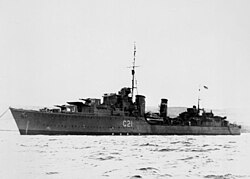Ships
The convoy consisted of 25 merchant ships and was accompanied by one auxiliary, the oiler RFA Gray Ranger, which travelled with a destroyer escort.
The Close Escort was led by Commander John Crombie in the minesweeper HMS Bramble and consisted of two other minesweepers and four trawlers, joined later by four destroyers and the anti-aircraft ship HMS Ulster Queen.
A Cruiser Cover Force (Rear Admiral Harold Burrough) in the light cruiser HMS Nigeria, with the heavy cruiser HMS London and two destroyers and a Distant Covering Force (Admiral John Tovey), comprising the battleships HMS King George V and USS Washington, (Rear Admiral Robert C. Giffen, USN, commanding), the aircraft carrier HMS Victorious, the heavy cruisers USS Tuscaloosa and Wichita, the light cruiser Kenya and ten destroyers. The convoy was also covered by a patrol of four submarines off Norway, guarding against a sortie by German warships.
Action
PQ 15 sailed from Reykjavík, Iceland, on 26 April 1942 with its local escort. This was joined on 28 April by the ocean escort, giving the convoy an immediate total escort of 12 warships.
German aircraft sighted the convoy on 28 April while it was 250 nmi (290 mi; 460 km)south-west of Bear Island. No attack developed for two days as the German forces were busy with the reciprocal Convoy QP 11, which left Murmansk in the Soviet Union on 28 April.
On 1 May the Luftwaffe made its first attack on PQ 15, by six Junkers Ju 88s. The German bombers failed to inflict any damage and lost one of their number. The Distant Cover Force suffered two losses when King George V and the destroyer HMS Punjabi collided in fog. Punjabi sank and King George V was forced to return to port. Her place in the group was taken by the battleship HMS Duke of York, which steamed from Scapa Flow to reinforce the escorts.
The escorts made an asdic contact on 2 May, which the destroyer HMS St. Albans and minesweeper HMS Seagull attacked. When the submarine was damaged and forced to the surface it was found to be the Polish Jastrzab, which was assigned to patrol off Norway but was some way out of position. Jastrzab was too badly damaged to continue and was scuttled.
On 3 May at 01:30 in the half light of the Arctic summer nights, six Heinkel He 111 bombers of I. Gruppe , Kampfgeschwader 26, the Luftwaffe's new torpedo bomber force, made the first German torpedo bomber attack of the war. Three ships were hit, two were sunk and one was damaged, later to be sunk by the German submarine U-251. Two aircraft were shot down and a third damaged, which subsequently crashed. A further attack by German high-level bombers at dusk was unsuccessful.
Deteriorating weather on 4 May prevented further attacks, an Arctic gale quickly turning into a snowstorm. PQ 15 arrived at the Kola Inlet at 21:00 on 5 May with no further losses.
This page is based on this
Wikipedia article Text is available under the
CC BY-SA 4.0 license; additional terms may apply.
Images, videos and audio are available under their respective licenses.
